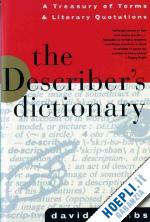Ever found yourself grasping in vain for that ideal descriptive word lost somewhere within the misty recesses of your vocabulary? Or felt frustrated that an oddly shaped structure or pretty setting you wished to portray in writing didn't quite translate clearly to paper? If you've ever stalled trying to depict the look of an object or animal or the looks of a particular person, The Describer's Dictionary is exactly the book you need. Open it, and you have not only just the right words but - bringing them to life - stellar literary examples of descriptive writing as well. The Dictionary concerns itself with the observable, from discrete shapes and patterns to buildings, terrain, furry and unfurry creatures, and human beings. "Referably" organized, the book uses a handy reverse, definition-to-term format that makes it easy for you to zero in on the term or terms you're seeking. For example, for a word that denotes an object's proper or harmonious dimensions, flip to the "Shapes" category and there you'll find "proportional", "proportionate", "commensurate", and "eurythmic". In some instances, where meanings are self-evident, simple listings of apt words are provided. As an inspiration to any writer - showing how it's done by the best - hundreds of colorful and evocative descriptive passages appear on facing pages, making this a singularly and richly different kind of reference book. The quotations are first-rate examples of how the book's terminology can be used. The excerpts are drawn from the best American and British novelists, naturalists, and other nonfiction writers, from Dickens to Updike, from Darwin to McPhee. The Describer's Dictionary - uniquely focused on the physical and freeof the categorical and multiple-meaning confusions of a thesaurus - is a must for anyone wanting to have at hand just the right words to describe exactly what is being observed or depicted. Within these covers you will find the answers to such questions as: What is the adj











